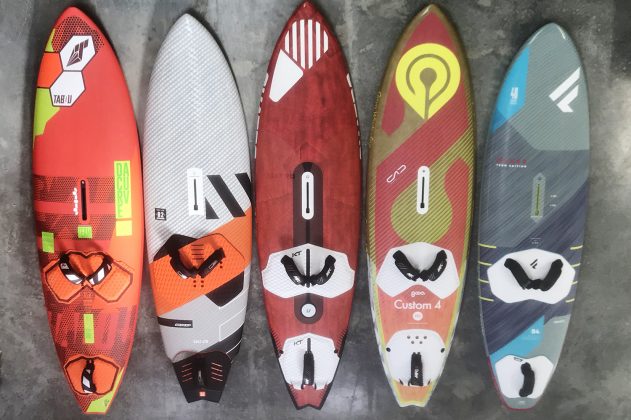THE FLOW OF EVOLUTION
85 LITRE WAVE BOARD TEST 2021
Test editor Sam Ross // Second testers Tris Best, Leo McCallin, Joe North and Chris Beng.
Test Locations Southbourne, Weymouth Bandstand and Kimmeridge
It’s hard to write anything at the moment without mentioning the impact of the global pandemic. R&D as well as production and shipment have all been interrupted, but despite that our test team still managed to test 5 wave boards which were featured in our Nov/Dec 2020 issue followed by a further 3 boards in our Jan/Feb 2021 issue. Testing was across a range of conditions from onshore bump and jump, all the way through to cross-shore with solid groundswell. Often picking a board is based on which conditions you sail most in, but many will want something that gives them more flexibility, especially if it’s their only wave board. The range of conditions we experienced certainly helped us find out what these boards were good at, but also what they were best at.
The first test was originally published in the November/ December 2020 followed by the catch up test in January / February 2021 issue of Windsurf Magazine.
FINDINGS
In last year’s wave board test we spoke about the gradual blurring of the lines between compact and conventional designs. Some of the visual hallmarks between the two are a little less obvious within this year’s crop as there is a significant confluence of planshapes and rocker lines across the range of boards. All the boards still sit towards compact or conventional, but unlike modern politics, the boards are much less at the extremes. All these boards have design attributes that make them excel in certain conditions, but with the blending of the styles there is much more crossover than ever before. All the boards in the test get going well; they reach fast and hold ground upwind well too. In the past you would have expected certain fin types to have strengths that were always coupled with a negative. Wave boards that turn tightly don’t plane early, quads are slow or thrusters have lots of drive but you can’t adjust your arc easily. All these designs have not only managed to maintain the benefits of certain setups but soften or eradicate these traditionally viewed Achilles heels of boards.
Bottom design seems to be the leading evolution across most of the boards in test, with many featuring a range of hull shapes across the breadth of the board from mono concave to V. Channels are also featured in more than half the boards, allowing more variation in rocker, but also hull shape. Notably the more compact designs both see more drawn in noses, and whilst they still have long parallel sections, this change in plan shape is there to help enhance their performance in more down the line conditions, rather than just their traditional onshore playgrounds.
As always when testing wave boards, the weight of the rider plays a large factor in findings. Test team rider weights for this review varied from 72-85 kg. For our testers these boards would work equally as a ‘one-board-only choice’ or a smaller board as part of a two-board quiver.
SUMMARY
The Tabou Da Curve is a conventional shape with a twist. Giving the best performance in side-shore conditions where the rails engage for ultimate drive, its new features mean it still has plenty of get up and go in more mundane conditions. The Cult Y26 from RRD is the board with the most striking design characteristics, incorporating all the key features of both a classic and conventional design. The result is a board that offers great drive and turning ability, but also a plug and play ‘blasty’ feel, all down to how you set it up, so tuning is well worth experimenting with. The Goya Custom 4 is a quad that not only turns on as conditions get better, but also offers incredible ‘real world’ wave potential.
On the other hand, the Quatro Pyramid deserves to be taken to where the conditions are best, coupling rail-to-rail performance with a fast outline. The Fanatic Mamba, hailing from the lineage of the Stubby, which originally helped set the bar in compact design, has design tweaks which have developed this into one of the most versatile boards out there. The Severne Pyro is a fast, extremely versatile board that can be tuned from super loose to more sure footed than a mountain goat. The Starboard UltraKode is a fast board with a fully connected feel, that allows the sailor to connect seamlessly from bottom to top turn, with the various fin options giving versatility across different conditions. The Naish Assault is fast, early planing and easy to sail, a user-friendly versatile bump and jump board that is still plenty of fun on the wave.
These boards blend performance across conditions more than ever before. There is a board for every sailor here, no matter what the ratio of mush to massive it is that you sail. Think about what conditions you encounter most, but also those that you are looking to access to make the right choice.
THE LINEUP

